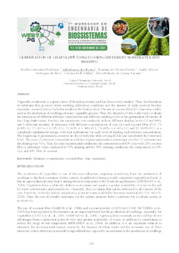Germination of chapolin® tomato using different substrates and shading.
Germination of chapolin® tomato using different substrates and shading.
Author(s): RODRIGUES, N. F.; OLIVEIRA, J. R. de; PEREIRA, M. de O.; SILVA, A. A. R. da; HÜTHER, C. M.; TAVARES, S. R. de L.
Summary: Vegetable production is a great source of Brazilian income and has been widely studied. Thus, the formation of substrates that promote better seedling cultivation conditions and the amount of light received become important research factors for better results in the final product. The use of coconut fiber (FC) has been widely used in the production of seedlings of many vegetable species. Thus, the objective of this work was to evaluate the interaction of different substrate compositions and different shading levels in the germination of tomato of the Chapolin® variety. For this, the experiment was conducted at three different shading levels (70 and 90%) and 5 different mixtures of substrates with different concentrations of clay (A) and coconut fiber (FC): T1 (100% A), T2 (80 % A + 20% FC), T3 (60% A + 40% FC), T4 (40% A + 60% FC) and T5 (100% FC), in a completely randomized design, with four replications for each level of shading and substrate concentration. The beginning of germination occurred on the seventh day after sowing (DAS) and lasted until the fourteenth DAS. The type of substrate concentration with the highest germination percentage was the T2 substrate and the shading was 70%. Thus, for such experimental conditions, the concentration of 80% clay with 20% coconut fiber is indicated, when conducted in 70% shading and for 90% shading conditions, the composition of 60% clay and 40% fiber of coconut.
Publication year: 2021
Types of publication: Paper in annals and proceedings
Unit: Embrapa Soils
Keywords: Argila, Clay, Coconut fiber, Fibra de coco, Luminosidade, Luminosity, Solanum lycopersicum
Observation
Some of Embrapa's publications are published as ePub files. To read them, use or download one of the following free software options to your computer or mobile device. Android: Google Play Books; IOS: iBooks; Windows and Linux: Calibre.
Access other publications
Access the Agricultural Research Database (BDPA) to consult Embrapa's full library collection and records.
Visit Embrapa Bookstore to purchase books and other publications sold by Embrapa.

